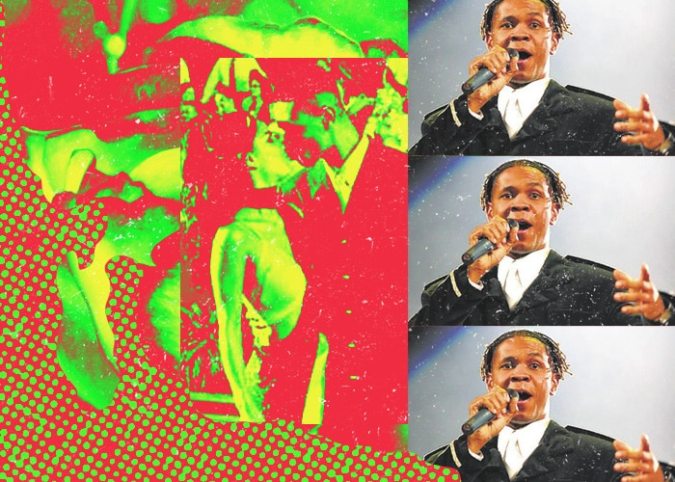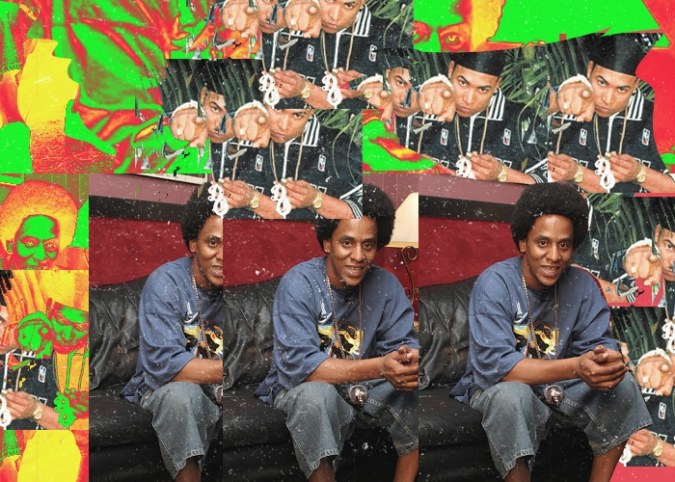Reggaeton began organically as a transformation of dancehall, hip-hop, and reggae en español. As an Afro-diasporic movement, Panama, Puerto Rico, Jamaica, the Dominican Republic, and New York are all pivotal landscapes in the style’s musical evolution. Through Tu Pum Pum: The Story of Reggaeton, a new column by Eddie Cepeda, we’ll explore reggaeton’s history, sociopolitical struggles, and its impact as a global force in music and culture.
In 2017, “Despacito” became a global pop culture phenomenon. It was nominated for Song of the Year and Record of the Year at the 2018 Grammys, the first mostly Spanish-language track to hold that honor in both categories.
But its success last year was complicated. Some fans and critics viewed reggaeton’s re-entry to the top of the U.S. charts as a come-up for Latinxs in the music industry – a cathartic affirmation of our place not only in the United States, but throughout the world. The fact that a Spanish-language song reached no. 1 on the Billboard Hot 100 in the era of Donald Trump’s raging vitriol can be framed as a testament to the enduring legacy of our cultures. Yet others view it not as a triumph, but reggaeton’s blanqueamiento – an affront to the Afro-diasporic pioneers who literally had to fight for their right to dembow.
As a new wave of highly marketable pop-reggaeton has taken hold of the music industry, the artists at the forefront of the movement have started to look less and less like the genre’s pioneers. Many see these stars as purposely palatable to white, North American audiences – and light-skinned and white Latinos, whose class privilege helped shape negative attitudes towards reggaeton during its commercial explosion. But it wasn’t long ago that the genre now proudly touted as “Reggaeton Latino” existed within a subculture shunned by mainstream society.


Before Justin Bieber talked his way into reggaeton history, and before Luis Fonsi was named Puerto Rico’s tourism ambassador in the whirlwind of “Despacito’s” success, reggaeton had to battle for acceptance. It existed as a lowbrow, stigmatized genre, shackled to a legacy of racism and colorism, first in Panama, and then in Puerto Rico once it was consolidated as the music we recognize today.
Reggaeton’s blanqueamiento is an affront to the Afro-diasporic pioneers who literally had to fight for their right to dembow.
Proto-reggaeton, or “underground,” began in part when Vico C and DJ Negro met in the mid-80s. Their mutual affinity for Afro-diasporic music included hip-hop, dancehall, the plena of Panama, and beyond. They’re viewed as the godfathers of reggaeton, although the sampled beats on their early underground mixtapes came mostly from mainland hip-hop records. These early tapes have few signs of the dembow riddim, but they opened the door for Spanish-language rappers in Puerto Rico to have a platform. Initially only producing about 20 copies (according to scholar Raquel Z. Rivera), the music spread through informal distribution networks, with fans sharing and copying the tapes mostly within caseríos, public housing projects in Puerto Rico.
At first, the underground movement went largely unnoticed by those outside the projects, considering the caseríos were (and to a large extent still are) some of the most neglected and marginalized communities of Puerto Rico. But the organic growth of the genre via the bootleg tapes and CDs eventually captured the attention of local audiences.

Then, reggae en español, pioneered by Panamanian descendants of West Indians who migrated to the isthmus to work on the Panama Canal, began circulating in Puerto Rico. Panamanian plena from artists like El General, Nando Boom, and Renato influenced underground artists on the island. “Reggae” or dembow riddims started dominating the scene as underground grew. The danceability of the dembow riddim, with the addition of timbal accents on the backbeat, fueled early reggaeton’s popularity. By the time DJ Playero’s wildly successful Playero 38 was released in 1994, dembow drove the sound of underground. Featuring performances from Daddy Yankee (Yankee’s debut was on Playero’s Playero 34 in 1992), Frankie Boy and Yaviah, Playero 38 helped catapult underground into the bedrooms, clubs, and Walkmans of Puerto Rico’s youth. The 1994 release of Wiso G’s Sin Parar, the first underground album on an official record label (NRT Inc.), brought the kind of attention and notoriety that sent mainstream Puerto Rican culture into a full hysteria against the genre.

During the anti-crime initiative Mano Dura Contra el Crimen, championed by then newly elected governor Pedro Rosselló, and lasting from 1993-1999, government officials targeted reggaeton fans by raiding caseríos where the genre was flourishing. The music incensed the Puerto Rican government to the extent that raids included record stores that sold mixtapes. This censorship – justified by writers and politicians with a profound disdain for reggaeton – bore a striking resemblance to the censorship faced by the bomba of the previous generation. In February of 1995, Puerto Rico’s police department, in conjunction with the National Guard, raided six record stores in and around San Juan. The raids were part of Operation Centurion, which fell under the Mano Dura Contra el Crimen, and sought to control the marginalized communities of Puerto Rico’s population in the caseríos. As Petra Rivera-Rideau writes in her book Remixing Reggaeton, Operation Centurion marked these poor, mostly black neighborhoods as key sites for violence, hypersexuality, and drug use.
Reggaeton was officially contraband.
The raids weren’t meant to seize drugs, weapons, or even to stop prostitution. The targets were cassettes. The demand for underground tapes had spread out of the urban core and into the suburbs of Puerto Rico, where the children of well-to-do business people and politicians had perreo fever. Fueled by the conservative watch group Morality in Media, the anti-reggaeton campaign raged on. Citing violent and hypersexualized lyrics, Morality in Media argued that Puerto Rico’s youth was being led to indulge in rampant sex, drugs, and violence against others. Subsequent raids on public schools focused on the confiscation of weapons, drug paraphernalia, alcohol, and underground music. Reggaeton was officially contraband.

There’s no denying that reggaeton’s subject matter did often highlight violence, sexuality, and misogyny – though Afro Puerto Rican artists like Tego Calderón used the platform early on to voice their issues with classism and racism. But the thought of criminalizing free speech was absurd, as history showed time and time again that it was bound to fail. Many reggaetoneros chose to refocus their lyrical content, a move that only brought more attention to the embattled genre and its proponents.
Aside from the temporary inconvenience of lost merchandise and frivolous arrests, the raids on the stores did little to curb reggaeton’s ascent. But the op-eds, press conferences, and raids persisted – and with them came a groundswell in reggaeton’s popularity. More and more of the population embraced the genre, as elements of Puerto Rico’s folkloric identity seeped into the music. Though dembow – a riddim read as “black” – remained at the center, the sound shifted to include instrumentation traditionally associated with Latin music, like timbales and the tres. Luny Tunes’ Mas Flow and Tego Calderón’s El Abayarde (both released in 2003) used more obvious cultural signifiers of Latinidad with their heavy bachata guitar riffs and bomba influences. These inherited musical legacies melded with reggaeton’s identity, taking the genre – as Wayne Marshall said in a 2009 anthology about reggaeton’s commercialization – “from música negra” to “reggaeton Latino,” which meant heightened acceptance among Puerto Rico’s white population.

But the government wasn’t ready to give up the fight. The next target of their ire was the alleged pornography and objectification of women in music videos. Like the Mano Dura era, this attack also fell flat, as many of the women in the videos praised the opportunities they carved out as a result of their appearances. Some, like Jenny la Sexy Voz and Glory, used their sexuality to game a fundamentally patriarchal and oppressive system, crafting important roles as backup up singers or eventually branching out into solo careers.

Reggaeton’s domination is important for Latinx visibility on a global scale, but at what price?
Reggaeton wouldn’t be stopped; its popularity grew exponentially with each passing political condemnation. As we all know, Daddy Yankee’s “Gasolina” and N.O.R.E.’s “Oye Mi Canto” catapulted reggaeton into the international lexicon in the mid-aughts. Don Omar declared the genre “Reggaeton Latino,” while Luny Tunes familiarized the world with bachata-style requintos. Artists like Shakira and Alejandro Sanz jumped on the trend, pushing reggaeton towards a more widely acceptable, “whitened” iteration.
As the success of “Despacito” shows, reggaeton is now pop music. “Despacito” holds a similar historical significance as the “Macarena;” both are the only mostly Spanish-language songs to reach no. 1 on the American charts since “La Bamba.” Both are pasteurized versions of genres that were once black and marginalized, but gained mainstream visibility, and thus white acceptance: “Macarena” with its faux-techno foundation, “Despacito,” a standard pop number with a dembow-derived rhythm. And both are songs about sexual gratification that have surely tricked more than their fair share of church-going suburbanites into dancing on a cruise ship.
But no matter how many records a reggaeton single breaks, some will continue to attack the genre they perceive as low-class and crude – like Aleks Syntek, who recently suggested the genre comes from apes, a snide and racist reference to its black roots.

Colorism is alive and strong, and people like Syntek seemingly face little backlash for their contemptuous views on black culture. Nevermind the fact that Syntek is deeply indebted to the Afro-diasporic genres of hip-hop and house in many of his endeavors, including the unintentionally comical project Calo.
It’s more important now than ever to tell the story of how reggaeton got here.
Reggaeton has come a long way from the besieged “música negra” of the caseríos. And it’s more important now than ever to tell the story of how it got here. Reggaeton’s increased visibility will undoubtedly lead to further dilution of the genre, which purists say is already coming in the form of the “sanded-down” new wave of Colombian artists leading the genre’s charge over the charts. The gradual blanqueamiento of a genre is nothing new. Jazz, blues, and disco have all suffered from similar battles – both from attempted regulation and from industry sanitization. The Larry Levans of yesteryear are replaced by the Diplos of today.
Musical commodification is never monolithic. There’s complex nuance in a genre’s growth. Reggaeton’s domination is important for Latinx visibility on a global scale, but at what price? As the genre increases in acceptance and popularity, it’s key to remember that it was considered low-class and dangerous when it was predominantly read as black. The image that reggaeton’s new wave of marketable, light-skinned stars portray sweeps its origins as “música negra” under the rug, and affirms colorism’s strong grip on Latin American culture. That’s not to say that the artists leading reggaeton’s pop surge shouldn’t be allowed to the party. But a truly inclusive understanding of Latinidad and its diverse, complex communities should represent all facets of it – especially the Afro-diasporic communities who created it.




